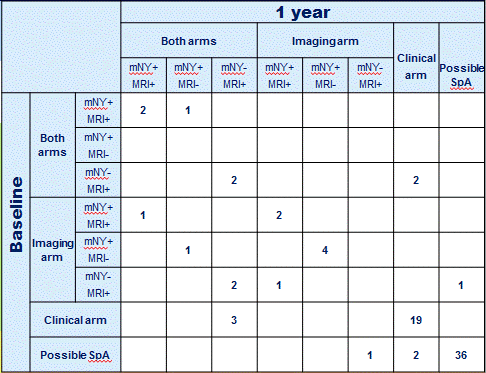Session Information
Session Type: Abstract Submissions (ACR)
Background/Purpose: It is known that in axial spondyloarthritis (axSpA) inflammatory lesions on MRI of the SI joints (MRI-SI) can change over time. The usefulness of repeating imaging in the diagnostic process is unclear. The aim is to investigate how patients with short-term chronic back pain are classified by the ASAS axSpA- criteria at baseline and after 1 year follow-up, with a focus on the role of imaging.
Methods: Patients in the SPACE cohort (back pain: ≥ 3 months, ≤ 2 years, onset < 45 years) with (suspicion of) axSpA underwent MRI and X-rays of the sacroiliac joints at baseline and 1 year follow-up. Only patients with complete MRI- and X-SI data at both baseline and year 1 were included in the analysis (n=80). MRI-SI and X-SI were scored independently by 3 well-calibrated readers according to the ASAS definition for a positive MRI and the mNY-criteria. Readers were blinded for patient characteristics and time sequence. Fulfillment of ASAS or mNY criteria was considered positive if 2/3 readers agreed. For each timepoint, patients were classified according the ASAS axSpA criteria and grouped in different arms (imaging arm: mNY+/- or MRI+/-; clinical arm, fulfillment of both arms and possible axSpA). In contrary to the normal application of the criteria, where a positive feature remains positive, we grouped patients according to the finding at one year, ignoring previous imaging findings.
Results: At baseline, 41/80 patients (32.8%) fulfilled the ASAS criteria (clinical arm: 22; imaging arm: 12, both arms: 7) (table). After 1 year, 3 additional patients fulfilled the criteria (2 clinical arm; 1 imaging arm). After 1 year, in 5 patients MRI-SI became positive and 1 patient fulfilled the mNY criteria. On the other hand, MRI-SI became negative after 1 year in 4 other patients. Of these patients, 3 still fulfilled the ASAS criteria (imaging arm (mNY+, n=1) or clinical arm (n=2)). Only 1 patient (classified axSpA at baseline) would be missed if imaging would have been performed at 1 year only (due to a negative MRI).
Conclusion: With one year longer symptom duration, 3/39 (8%) of the possible SpA patients could be classified additionally as axSpA because of additional SpA features (5%) or positive MRI (3%), while 1/41 (2%) of the axSpA patients would not be classified due to a normal MRI. Therefore, our data show the robustness of the axSpA criteria and does not support repeating imaging after one year.
Disclosure:
P. Bakker,
None;
M. de Hooge,
None;
R. van den Berg,
None;
F. van Gaalen,
None;
M. Reijnierse,
None;
T. W. J. Huizinga,
None;
D. van der Heijde,
None.
« Back to 2014 ACR/ARHP Annual Meeting
ACR Meeting Abstracts - https://acrabstracts.org/abstract/impact-of-repeating-imaging-of-the-sacro-iliac-joints-over-one-year-on-the-classification-according-the-asas-axial-spa-criteria-of-patients/

